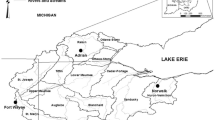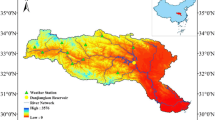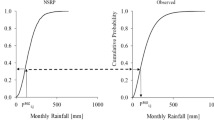Abstract
Daily and sub-daily weather data are often required for hydrological and environmental modeling. Various weather generator programs have been used to generate synthetic climate data where observed climate data are limited. In this study, a weather data generator, ClimGen, was evaluated for generating information on daily precipitation, temperature, and wind speed at four tropical watersheds located in Hawai‘i, USA. We also evaluated different daily to sub-daily weather data disaggregation methods for precipitation, air temperature, dew point temperature, and wind speed at Mākaha watershed. The hydrologic significance values of the different disaggregation methods were evaluated using Distributed Hydrology Soil Vegetation Model. MuDRain and diurnal method performed well over uniform distribution in disaggregating daily precipitation. However, the diurnal method is more consistent if accurate estimates of hourly precipitation intensities are desired. All of the air temperature disaggregation methods performed reasonably well, but goodness-of-fit statistics were slightly better for sine curve model with 2 h lag. Cosine model performed better than random model in disaggregating daily wind speed. The largest differences in annual water balance were related to wind speed followed by precipitation and dew point temperature. Simulated hourly streamflow, evapotranspiration, and groundwater recharge were less sensitive to the method of disaggregating daily air temperature. ClimGen performed well in generating the minimum and maximum temperature and wind speed. However, for precipitation, it clearly underestimated the number of extreme rainfall events with an intensity of >100 mm/day in all four locations. ClimGen was unable to replicate the distribution of observed precipitation at three locations (Honolulu, Kahului, and Hilo). ClimGen was able to reproduce the distributions of observed minimum temperature at Kahului and wind speed at Kahului and Hilo. Although the weather data generation and disaggregation methods were concentrated in a few Hawaiian watersheds, the results presented can be used to similar mountainous location settings, as well as any specific locations aimed at furthering the site-specific performance evaluation of these tested models.














Similar content being viewed by others
References
Abraha MG, Savage MJ (2006) Potential impacts of climate change on the grain yield of maize for the midlands of KwaZulu-Natal, South Africa. Agric Ecosyst Environ 115:150–160
Acutis M, Donatelli M, Stockle, CO (1999) Performance of two weather generators as a function of the number of available years of measured climatic data. Proceedings First International Symposium Modelling Cropping Systems, Lleida, Spain, 21–23 June, pp 129–130
Allen RG, Smith M, Pereira LS, Perrier A (1994) An update for the calculation of reference evapotranspiration. ICID Bull 43:35–92
Arnold JG, Williams JR (1989) Stochastic generation of internal storm structure at a point. Transactions of the ASAE 32(1):161–167
Bilbao J, Miguel A, Kambezidis HD (2002) Air temperature model evaluation in the north Mediterranean Belt area. J Appl Meteorol 41:872–884
Burian SJ, Durrans SR, Tomic S, Pimmel RL, Wai CN (2000) Rainfall disaggregation using artificial neural networks. J Hydrol Eng 5(3):299–307
Burman RD, Pochop LO (1994) Evaporation, evapotranspiration and climatic data. Developments in atmospheric science. Elsevier, Amsterdam
Castellvi F, Stockle, CO (2001) Comparing the performance of WGEN and ClimGen in the generation of temperature and solar radiation. Trans of ASAE 44:1683–1687
Chen YL, Nash AJ (1994) Diurnal variation of surface airflow and rainfall frequencies on the island of Hawai‘i. Mon Weather Rev 122:34–56
Chu PS, Chen H (2005) Interannual and interdecadal rainfall variations in the Hawaiian Islands. J Climate 18:4796–4813
Chu PS, Zhao X, Ruan Y, Grubbs M (2009) Extreme rainfall events in the Hawaiian Islands. J Appl Meteor Climatol 48:502–516
Danuso F, Della MV (1997) CLIMAK reference manual. DPVTA, University of Udine, Italy
de Wit CT (1978) Simulation of assimilation, respiration and transpiration of crops. Wageningen, Pudoc, p 148
Debele B, Srinivasan R, Parlange JY (2007) Accuracy evaluation of weather data generation and disaggregation methods at finer timescales. Adv Water Resour 30:1286–1300
Ephrath JE, Goudriaan J, Marani A (1996) Modelling diurnal patterns of air temperature, radiation wind speed and relative humidity by equations from daily characteristics. Agric Syst 51(4):377–393
Erbs DG (1984) Models and applications for weather statistics related to building heating and cooling loads. Ph.D. thesis, Mechanical Engineering Department, University of Wisconsin-Madison, Wisconsin, Madison, 336 pp
ESRA (2000) European solar radiation atlas (ESRA). In: Scharmer K, Greif J (eds) Database and exploitation software, vol. 2. Commission of the European Communities, Ecole des Mines de Paris, France
Fytilas P (2002) Multivariate rainfall disaggregation at a fine time scale (diploma thesis). University of Rome, La Sapienza
Giambelluca TW, Nullet D (1991) Influence of the trade-wind inversion on the climate of a leeward mountain slope in Hawaii. Clim Res 1:207–216
Gutierrez-Magness AL, McCuen RH (2004) Accuracy evaluation of rainfall disaggregation methods. J Hydrol Eng 9(2):71–78
Johnson GL, Hanson CL, Hardegree SP, Ballard EB (1996) Stochastic weather simulation: overview and analysis of two commonly used models. J Appl Meteorol 35:1878–1896
Katz RW, Brown BG (1994) Sensitivity of extreme events to climate change: the case of autocorrelated time series. Environmetrics 5:451–462
Koutsoyiannis D, Onof C, Wheater H (2003) Multivariate rainfall disaggregation at a fine time scale. Water Resour Res 39(7):1–18
Krause P, Boyle DP, Base F (2005) Comparison of different efficiency criteria for hydrological model assessment. Adv Geosci 5:89–97
Legates DR, McCabe GJ (1999) Evaluating the use of “goodness-of-fit” measures in hydrologic and hydroclimatic model validation. Water Resour Res 35(1):233–241
Mair A, Fares A (2010) Throughfall characteristics in three non-native Hawaiian forest stands. Agric For Meteorol 150:1453–1466
McCuen RH (2003) Modeling hydrologic change. CRC, Boca Raton
McKague K, Rudra R, Ogilvie J, Ahmed I, Gharabaghi B (2005) Evaluation of weather generator ClimGen for Southern Ontario. Can Water Resour J 30(4):315–330
Meteotest (2003) Meteonorm version 5.0. The global meteorological data base for engineers, planners and education. Software and data on CD-ROM. James and James, London
Moriasi BN, Arnold JG, Van Liew MW, Bingner RL, Harmel RD, Veith TL (2007) Model evaluation guidelines for systematic quantification of accuracy in watershed simulations. Trans ASABE 50(3):885–900
Nicks AD, Gander GA (1994) CLIGEN: a weather generator for climate inputs to water resource and other models. In: Watson DG, Zazueta FS, Harrison TV (eds) Proceedings of the Fifth International Conference on Computer in Agriculture, 1994. ASAE, St Joseph, pp 903–909
Nicks AD, Richardson CW, Williams JR (1990) Evaluation of the EPIC model weather generator. In: Sharpley AN, Williams JR (eds) EPIC—erosion/productivity impact calculator, 1. Model documentation. USDA Technical Bulletin No. 1768, Government Printing Office, Washington, DC, pp 105–124
Parton WJ, Logan JA (1981) A model for diurnal variation in soil heat flux and net radiation. Agric Meteorol 23:205–216
Richardson CW, Nicks AD (1990) Weather generation description. In: Sharpley AN, Williams JR (eds) EPIC—Erosion/Productivity Impact Calculator, 1. Models documentation, USDA Technical Bulletin No. 1768. GPO, Washington, DC, pp 93–104
Richardson CW, Wright DA (1984) WGEN: a model for generating daily weather variables. USDA, Agricultural Research Services, Bulletin No. ARS-8. Government Printing Office, Washington, DC
Roy SS, Balling RC Jr (2004) Analysis of Hawaiian diurnal rainfall patterns. Theor Appl Climatol 79:209–214
Running S, Nemani R, Hungerford R (1987) Extrapolation of synoptic meteorological data in mountainous terrain and its use for simulating forest evapotranspiration and photosynthesis. Can J For Res 17:472–483
Safeeq M (2010) The response of different hydrologic processes under changing land use/land cover and climate in Mākaha watershed, O’ahu. Ph.D. thesis, University of Hawaii at Manoa, HI, USA
Sahoo GB, Ray C, Carlo EHD (2006) Calibration and validation of a physically distributed hydrological model, MIKE SHE, to predict streamflow at high frequency in a flashy mountainous Hawaii stream. J Hydrol 327:94–109
Segond ML, Onof C, Wheater HS (2006) Spatial–temporal disaggregation of daily rainfall from a generalized linear model. J Hydrol 331(3–4):674–689
Selker JS, Haith DA (1990) Development and testing of single-parameter precipitation distribution. Water Resour Res 26(11):2733–2740
Socolofsky SA, Adams EE, Entekhabi D (2001) Disaggregation of daily rainfall for continuous watershed modeling. J Hydrol Eng 6(4):300–309
Stockle CO, Bellocchi G, Nelson R (1998) Evaluation of the weather generator ClimGen for several world locations. Seventh International Congress for Computer Technology in Agriculture, Italy
Stockle CO, Campbell GS, Nelson R (1999) ClimGen manual. Biological Systems Engineering Department, Washington State University, Pullman
Waichler SR, Wigmosta MS (2003) Development of hourly meteorological values from daily data and significance to hydrological modeling at H. J. Andrews Experimental Forest. J Hydrometeor 4:251–263
Weibull W (1951) A statistical distribution function of wide applicability. J Appl Mech-Trans ASME 18(3):293–297
Wigmosta MS, Lettenmaier DP, Vail LW (1994) A distributed hydrology–vegetation model for complex terrain. Water Resour Res 30(6):1665–1679
Willmott CJ (1981) On the validation of models. Phys Geogr 2:184–194
Willmott CJ (1982) Some comments on evaluation of model performance. Bull Am Meteorol Soc 63(11):1309–1313
Zhang J, Murch RR, Ross MA, Ganguly AR, Nachabe M (2008) Evaluation of statistical rainfall disaggregation methods using rain-gauge information for West-Central Florida. J Hydrol Eng 13(12):1158–1169
Acknowledgements
We thank Alan Mair for his assistance in establishing the climate monitoring network. The authors wish to thank Roger Nelson at Washington State University for assisting with ClimGen and providing technical supports. The authors also wish to thank the Honolulu Board of Water Supply and members of Mohala I Ka Wai for their assistance and cooperation. Finally, the authors would like to thank two reviewers for their constructive comments.
Author information
Authors and Affiliations
Corresponding author
Appendix
Appendix
Model bias (ē) and standard error (S e) were calculated as follows:
where P i and O i are the predicted and observed data at any given time i, and N is the total number of data points.
If the model is reliable, then S e will be significantly smaller than the standard deviation of measured data (S o). Thus, the ratio S e/S o ,which is known as relative standard error R s, is a dimensionless measure of the improvement in the accuracy of prediction (McCuen 2003). When R s is near zero, the model significantly improves the accuracy of prediction over the mean; however, when R s is near 1.0, the model provides no improvement in prediction compared to the mean. Other dimensionless indices such as relative bias (R b), relative standard error (R s), relative difference between observed and predicted standard deviations (ΔS), and significance of difference test (Test) were calculated as follows:
where \( \bar{O} \) and \( \bar{P} \) are the mean of observed and predicted weather data, respectively, and S p is the standard deviation of predicted weather data. The closer the values of R b, R s, and ΔS to zero, the better the models are. The significant difference test was evaluated based on a two tailed z-test at 95% significance level. If the test values are greater than 1.0, then the difference between observed and predicted data is significant.
The index of agreement (d 2) proposed by Willmott (1981, 1982) represents the ratio between mean square error and the potential error. The d 2 can detect additive and proportional differences in the observed and simulated means and variances. However, d 2 is often criticized for its over-sensitivity to extreme values due to squared differences. Legates and McCabe (1999) suggested a modified version of index of agreement (d 1) that is less sensitive to extreme values. The index of agreement ranges between 0 and 1, where a value of 1 indicates a perfect agreement and a value of 0 indicates no agreement at all. The index of agreement (d 2) and its modified form (d 1) were estimated as follows:
and
Rights and permissions
About this article
Cite this article
Safeeq, M., Fares, A. Accuracy evaluation of ClimGen weather generator and daily to hourly disaggregation methods in tropical conditions. Theor Appl Climatol 106, 321–341 (2011). https://doi.org/10.1007/s00704-011-0438-4
Received:
Accepted:
Published:
Issue Date:
DOI: https://doi.org/10.1007/s00704-011-0438-4




